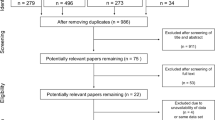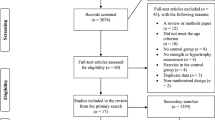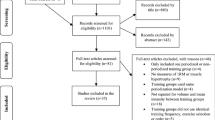Abstract
Physical activity recommendations for public health include typically muscle-strengthening activities for a minimum of 2 days a week. The range of inter-individual variation in responses to resistance training (RT) aiming to improve health and well-being requires to be investigated. The purpose of this study was to quantify high and low responders for RT-induced changes in muscle size and strength and to examine possible effects of age and sex on these responses. Previously collected data of untrained healthy men and women (age 19 to 78 years, n = 287 with 72 controls) were pooled for the present study. Muscle size and strength changed during RT are 4.8 ± 6.1 % (range from −11 to 30 %) and 21.1 ± 11.5 % (range from −8 to 60 %) compared to pre-RT, respectively. Age and sex did not affect to the RT responses. Fourteen percent and 12 % of the subjects were defined as high responders (>1 standard deviation (SD) from the group mean) for the RT-induced changes in muscle size and strength, respectively. When taking into account the results of non-training controls (upper 95 % CI), 29 and 7 % of the subjects were defined as low responders for the RT-induced changes in muscle size and strength, respectively. The muscle size and strength responses varied extensively between the subjects regardless of subject’s age and sex. Whether these changes are associated with, e.g., functional capacity and metabolic health improvements due to RT requires further studies.





Similar content being viewed by others
References
Ahtiainen JP, Hulmi JJ, Kraemer WJ, Lehti M, Pakarinen A, Mero AA, Karavirta L, Sillanpää E, Selänne H, Alen M et al (2009) Strength, [corrected] endurance or combined training elicit diverse skeletal muscle myosin heavy chain isoform proportion but unaltered androgen receptor concentration in older men. Int J Sports Med 30:879–887. doi:10.1055/s-0029-1238290
Ahtiainen JP, Hulmi JJ, Kraemer WJ, Lehti M, Nyman K, Selänne H, Alen M, Pakarinen A, Komulainen J, Kovanen V et al (2011) Heavy resistance exercise training and skeletal muscle androgen receptor expression in younger and older men. Steroids 76:183–192. doi:10.1016/j.steroids.2010.10.012
Bamman MM, Petrella JK, Kim JS, Mayhew DL, Cross JM (2007) Cluster analysis tests the importance of myogenic gene expression during myofiber hypertrophy in humans. J Appl Physiol (1985) 102:2232–2239. doi:10.1152/japplphysiol.00024.2007
Campbell WW, Leidy HJ (2007) Dietary protein and resistance training effects on muscle and body composition in older persons. J Am Coll Nutr 26:696S–703S
Davidsen PK, Gallagher IJ, Hartman JW, Tarnopolsky MA, Dela F, Helge JW, Timmons JA, Phillips SM (2011) High responders to resistance exercise training demonstrate differential regulation of skeletal muscle microRNA expression. J Appl Physiol (1985) 110:309–317. doi:10.1152/japplphysiol.00901.2010
Devaney JM, Tosi LL, Fritz DT, Gordish-Dressman HA, Jiang S, Orkunoglu-Suer FE, Gordon AH, Harmon BT, Thompson PD, Clarkson PM et al (2009) Differences in fat and muscle mass associated with a functional human polymorphism in a post-transcriptional BMP2 gene regulatory element. J Cell Biochem 107:1073–1082. doi:10.1002/jcb.22209
Erskine RM, Jones DA, Williams AG, Stewart CE, Degens H (2010) Inter-individual variability in the adaptation of human muscle specific tension to progressive resistance training. Eur J Appl Physiol 110:1117–1125. doi:10.1007/s00421-010-1601-9
Garber CE, Blissmer B, Deschenes MR, Franklin BA, Lamonte MJ, Lee IM, Nieman DC, Swain DP, American College of Sports Medicine (2011) American College of Sports Medicine position stand. Quantity and quality of exercise for developing and maintaining cardiorespiratory, musculoskeletal, and neuromotor fitness in apparently healthy adults: guidance for prescribing exercise. Med Sci Sports Exerc 43:1334–1359. doi:10.1249/MSS.0b013e318213fefb
Häkkinen K, Kallinen M, Izquierdo M, Jokelainen K, Lassila H, Mälkiä E, Kraemer WJ, Newton RU, Alen M (1998) Changes in agonist-antagonist EMG, muscle CSA, and force during strength training in middle-aged and older people. J Appl Physiol (1985) 84:1341–1349
Häkkinen K, Pakarinen A, Kraemer WJ, Häkkinen A, Valkeinen H, Alen M (2001a) Selective muscle hypertrophy, changes in EMG and force, and serum hormones during strength training in older women. J Appl Physiol 1985 91:569–580
Häkkinen K, Alen M, Kallinen M, Newton RU, Kraemer WJ (2000a) Neuromuscular adaptation during prolonged strength training, detraining and re-strength-training in middle-aged and elderly people. Eur J Appl Physiol 83:51–62. doi:10.1007/s004210000248
Häkkinen K, Pakarinen A, Kraemer WJ, Newton RU, Alen M (2000b) Basal concentrations and acute responses of serum hormones and strength development during heavy resistance training in middle-aged and elderly men and women. J Gerontol A Biol Sci Med Sci 55:B95–B105
Häkkinen K, Kraemer WJ, Newton RU, Alen M (2001b) Changes in electromyographic activity, muscle fibre and force production characteristics during heavy resistance/power strength training in middle-aged and older men and women. Acta Physiol Scand 171:51–62. doi:10.1046/j.1365-201X.2001.00781.x
Holviala JH, Sallinen JM, Kraemer WJ, Alen MJ, Häkkinen KK (2006) Effects of strength training on muscle strength characteristics, functional capabilities, and balance in middle-aged and older women. J Strength Cond Res 20:336–344. doi:10.1519/R-17885.1
Holviala J, Häkkinen A, Karavirta L, Nyman K, Izquierdo M, Gorostiaga EM, Avela J, Korhonen J, Knuutila VP, Kraemer WJ et al (2010) Effects of combined strength and endurance training on treadmill load carrying walking performance in aging men. J Strength Cond Res 24:1584–1595. doi:10.1519/JSC.0b013e3181dba178
Holviala J, Kraemer WJ, Sillanpää E, Karppinen H, Avela J, Kauhanen A, Häkkinen A, Häkkinen K (2012) Effects of strength, endurance and combined training on muscle strength, walking speed and dynamic balance in aging men. Eur J Appl Physiol 112:1335–1347. doi:10.1007/s00421-011-2089-7
Hopkins WG (2000) Measures of reliability in sports medicine and science. Sports Med 30:1–15
Hubal MJ, Gordish-Dressman H, Thompson PD, Price TB, Hoffman EP, Angelopoulos TJ, Gordon PM, Moyna NM, Pescatello LS, Visich PS et al (2005) Variability in muscle size and strength gain after unilateral resistance training. Med Sci Sports Exerc 37:964–972
Hulmi JJ, Kovanen V, Selänne H, Kraemer WJ, Häkkinen K, Mero AA (2009) Acute and long-term effects of resistance exercise with or without protein ingestion on muscle hypertrophy and gene expression. Amino Acids 37:297–308. doi:10.1007/s00726-008-0150-6
Karavirta L, Häkkinen A, Sillanpää E, Garcia-Lopez D, Kauhanen A, Haapasaari A, Alen M, Pakarinen A, Kraemer WJ, Izquierdo M et al (2011a) Effects of combined endurance and strength training on muscle strength, power and hypertrophy in 40-67-year-old men. Scand J Med Sci Sports 21:402–411. doi:10.1111/j.1600-0838.2009.01059.x
Karavirta L, Häkkinen K, Kauhanen A, Arija-Blazquez A, Sillanpää E, Rinkinen N, Häkkinen A (2011b) Individual responses to combined endurance and strength training in older adults. Med Sci Sports Exerc 43:484–490. doi:10.1249/MSS.0b013e3181f1bf0d
Mann S, Beedie C, Balducci S, Zanuso S, Allgrove J, Bertiato F, Jimenez A (2014) Changes in insulin sensitivity in response to different modalities of exercise: a review of the evidence. Diabetes Metab Res Rev 30:257–268. doi:10.1002/dmrr.2488
Mayhew DL, Hornberger TA, Lincoln HC, Bamman MM (2011) Eukaryotic initiation factor 2B epsilon induces cap-dependent translation and skeletal muscle hypertrophy. J Physiol 589:3023–3037. doi:10.1113/jphysiol.2010.202432
Mero AA, Hulmi JJ, Salmijärvi H, Katajavuori M, Haverinen M, Holviala J, Ridanpää T, Häkkinen K, Kovanen V, Ahtiainen JP et al (2013) Resistance training induced increase in muscle fiber size in young and older men. Eur J Appl Physiol 113:641–650. doi:10.1007/s00421-012-2466-x
Mikkola J, Rusko H, Izquierdo M, Gorostiaga EM, Häkkinen K (2012) Neuromuscular and cardiovascular adaptations during concurrent strength and endurance training in untrained men. Int J Sports Med 33:702–710. doi:10.1055/s-0031-1295475
Mitchell CJ, Churchward-Venne TA, Bellamy L, Parise G, Baker SK, Phillips SM (2013) Muscular and systemic correlates of resistance training-induced muscle hypertrophy. PLoS One 8:e78636. doi:10.1371/journal.pone.0078636
Oja P, Titze S (2011) Physical activity recommendations for public health: development and policy context. EPMA J 2:253–259. doi:10.1007/s13167-011-0090-1
Petrella JK, Kim JS, Mayhew DL, Cross JM, Bamman MM (2008) Potent myofiber hypertrophy during resistance training in humans is associated with satellite cell-mediated myonuclear addition: a cluster analysis. J Appl Physiol (1985) 104:1736–1742. doi:10.1152/japplphysiol.01215.2007
Phillips BE, Williams JP, Gustafsson T, Bouchard C, Rankinen T, Knudsen S, Smith K, Timmons JA, Atherton PJ (2013) Molecular networks of human muscle adaptation to exercise and age. PLoS Genet 9:e1003389. doi:10.1371/journal.pgen.1003389
Raue U, Trappe TA, Estrem ST, Qian HR, Helvering LM, Smith RC, Trappe S (2012) Transcriptome signature of resistance exercise adaptations: mixed muscle and fiber type specific profiles in young and old adults. J Appl Physiol (1985) 112:1625–1636. doi:10.1152/japplphysiol.00435.2011
Riechman SE, Balasekaran G, Roth SM, Ferrell RE (2004) Association of interleukin-15 protein and interleukin-15 receptor genetic variation with resistance exercise training responses. J Appl Physiol (1985) 97:2214–2219
Sallinen J, Pakarinen A, Fogelholm M, Alen M, Volek JS, Kraemer WJ, Häkkinen K (2007) Dietary intake, serum hormones, muscle mass and strength during strength training in 49–73-year-old men. Int J Sports Med 28:1070–1076. doi:10.1055/s-2007-965003
Sillanpää E, Häkkinen A, Nyman K, Mattila M, Cheng S, Karavirta L, Laaksonen DE, Huuhka N, Kraemer WJ, Häkkinen K (2008) Body composition and fitness during strength and/or endurance training in older men. Med Sci Sports Exerc 40:950–958. doi:10.1249/MSS.0b013e318165c854
Sillanpää E, Häkkinen A, Laaksonen DE, Karavirta L, Kraemer WJ, Häkkinen K (2010) Serum basal hormone concentrations, nutrition and physical fitness during strength and/or endurance training in 39-64-year-old women. Int J Sports Med 31:110–117. doi:10.1055/s-0029-1242811
Sipilä S, Suominen H (1991) Ultrasound imaging of the quadriceps muscle in elderly athletes and untrained men. Muscle Nerve 14:527–533. doi:10.1002/mus.880140607
Thalacker-Mercer AE, Petrella JK, Bamman MM (2009) Does habitual dietary intake influence myofiber hypertrophy in response to resistance training? A cluster analysis. Appl Physiol Nutr Metab 34:632–639. doi:10.1139/H09-038
Timpka S, Petersson IF, Zhou C, Englund M (2014) Muscle strength in adolescent men and risk of cardiovascular disease events and mortality in middle age: a prospective cohort study. BMC Med 12:62
Van Deveire KN, Scranton SK, Kostek MA, Angelopoulos TJ, Clarkson PM, Gordon PM, Moyna NM, Visich PS, Zoeller RF, Thompson PD et al (2012) Variants of the ankyrin repeat domain 6 gene (ANKRD6) and muscle and physical activity phenotypes among European-derived American adults. J Strength Cond Res 26:1740–1748. doi:10.1519/JSC.0b013e31825c2bef
Walker S, Peltonen H, Sautel J, Scaramella C, Kraemer WJ, Avela J, Häkkinen K (2014) Neuromuscular adaptations to constant vs. variable resistance training in older men. Int J Sports Med 35:69–74. doi:10.1055/s-0033-1343404
Walker S, Peltonen H, Hakkinen K (2015) Medium-intensity, high-volume “hypertrophic” resistance training did not induce improvements in rapid force production in healthy older men. Age (Dordr) 37:9786. doi:10.1007/s11357-015-9786-9
Walsh S, Haddad CJ, Kostek MA, Angelopoulos TJ, Clarkson PM, Gordon PM, Moyna NM, Visich PS, Zoeller RF, Seip RL et al (2012) Leptin and leptin receptor genetic variants associate with habitual physical activity and the arm body composition response to resistance training. Gene 510:66–70. doi:10.1016/j.gene.2012.08.020
Westcott WL (2012) Resistance training is medicine: effects of strength training on health. Curr Sports Med Rep 11:209–216. doi:10.1249/JSR.0b013e31825dabb8
Xu L, Nicholson P, Wang QJ, Wang Q, Alen M, Cheng S (2010) Fat mass accumulation compromises bone adaptation to load in Finnish women: a cross-sectional study spanning three generations. J Bone Miner Res 25:2341–2349. doi:10.1002/jbmr.136
Acknowledgments
Studies included in the present investigation were funded by the following foundations: The Finnish Ministry of Culture and Education; Finnish Cultural Foundation; Ellen and Artturi Nyyssönen Foundation, Finland; Polar Electro Oy; Juho Vainio Foundation, Finland; Central Finland Health Care District, Jyväskylä, Finland; Sport Institute Foundation, Finland; Yrjö Jahnsson Foundation, Finland; and National Doctoral Programme of Musculoskeletal Disorders and Biomaterials, Finland.
Author information
Authors and Affiliations
Corresponding author
Ethics declarations
Subjects were carefully informed about the design of the study with special information on possible risks and benefits both verbally and in writing, and they signed a written consent form before participation in the study. The studies were conducted according to the Declaration of Helsinki and were approved by the Ethics Committee of the University of Jyväskylä, Finland, and/or by the Ethics Committee of the Central Finland Health Care District.
Conflict of interest
The authors declare that they have no competing interests.
Electronic supplementary material
Below is the link to the electronic supplementary material.
Supporting information 1
(PDF 641 kb)
Supporting information 2
(DOC 19.4 kb)
Supporting information 3
(PDF 20 kb)
About this article
Cite this article
Ahtiainen, J.P., Walker, S., Peltonen, H. et al. Heterogeneity in resistance training-induced muscle strength and mass responses in men and women of different ages. AGE 38, 10 (2016). https://doi.org/10.1007/s11357-015-9870-1
Received:
Accepted:
Published:
DOI: https://doi.org/10.1007/s11357-015-9870-1




